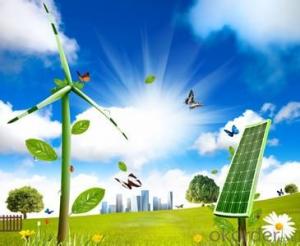Solar Cell Wholesale/monocrystalline silicon solar cell
- Loading Port:
- China Main Port
- Payment Terms:
- TT OR LC
- Min Order Qty:
- -
- Supply Capability:
- -
OKorder Service Pledge
OKorder Financial Service
You Might Also Like
Quick Details
| Model Number: | |||||
| Material: |
Packaging & Delivery
| Packaging Detail: | box, carton. denpending on the size of solar panels |
| Delivery Detail: | 10 days after receiving deposits |
Specifications
1.monocrystalline silicon solar panel
2.high efficiency
3.high transmission rate
4.high wind and hail impact resistanc
monocrystalline solar panel
1. High efficient, high reliable monocrystalline silicon solar cells ensure our product output stability
2. Unique frame design to reinforce sealing and to prevent freezing and warping
3. High transparency low iron tempered glass with enhanced stiffness and impact resistance
4. Advanced EVA encapsulation system with triple-layer back sheet meets the most stringent safety
requirements for high-voltage operation
5. Innovative and environmentally friendly packing
APPLICATIONS
1.Large on and off-grid solar power stations
2.Commercial/industrial building roof-top systems
3.Residential roof-top systems
4.Other industrial and commercial applications
| rated power (W) | 170 |
| short-circuit current (A) | 5.19 |
| open-circuit voltage(V) | 43.2 |
| size L*W*H(mm) | 1580*808*46 |
| weight(Kg) | 16.0 |
- Q:What are the advantages and disadvantages of solar panels and diodes?
- I first connected to a positive and negative, and then in the positive series more than one, is not it can be achieved to prevent short circuit, to prevent the return can also play a rectifier 3 role?
- Q:Can solar cells be used for powering wildlife tracking devices?
- Yes, solar cells can be used for powering wildlife tracking devices. Solar cells are a reliable and sustainable source of energy that can effectively power small electronic devices, including wildlife tracking devices. They can harness sunlight and convert it into electrical energy, providing a continuous power supply for tracking devices in remote locations where other power sources may be limited or unavailable.
- Q:Can solar cells be used in harsh climates?
- Yes, solar cells can be used in harsh climates. Solar cells are designed to withstand extreme weather conditions, including high temperatures, cold temperatures, and strong winds. They are often tested and certified to meet specific durability and performance standards, ensuring their reliability in harsh climates. Additionally, advancements in solar technology have led to the development of specialized solar panels that are specifically designed to perform well in extreme weather conditions, such as snow, hail, and sandstorms.
- Q:How do solar cells perform in areas with high levels of vibration?
- Solar cells are generally not affected by high levels of vibration as they are solid-state devices with no moving parts. Their performance remains unaffected, unless the vibration is severe enough to physically damage the solar panel or disrupt its alignment with the sun.
- Q:What materials are used to make solar cells?
- Solar cells are typically made using materials such as silicon, cadmium telluride, or copper indium gallium selenide (CIGS).
- Q:Can solar cells be used in theme parks or amusement parks?
- Yes, solar cells can definitely be used in theme parks or amusement parks. They can be installed to generate clean and renewable energy to power various attractions, lighting, and facilities within the park. Solar cells are a sustainable and cost-effective solution that can help reduce the carbon footprint of theme parks and contribute towards a greener environment.
- Q:Can solar cells be used for powering schools?
- Yes, solar cells can be used to power schools. Solar energy is a renewable and sustainable source of power, and installing solar panels on school rooftops or grounds can generate electricity to meet the energy needs of schools. This can significantly reduce the reliance on fossil fuels and decrease carbon emissions, making it an environmentally friendly solution. Additionally, solar power can provide a reliable and consistent energy source, especially in sunny regions, ensuring schools have a stable power supply.
- Q:What is the role of tracking systems in solar cell installations?
- The role of tracking systems in solar cell installations is to optimize the efficiency and output of the solar panels by adjusting their position and angle throughout the day to track the movement of the sun. This allows the panels to capture the maximum amount of sunlight and generate more electricity, increasing the overall performance and effectiveness of the solar cell installation.
- Q:How long does it take for solar cells to pay for themselves?
- The payback period for solar cells typically varies between 5 to 15 years, depending on factors like the initial cost, location, energy consumption, and available incentives.
- Q:I bought a new poly solar cells, and the test result of the conversion efficiency is 16.8%, is it lower than usual?
- I don't think it's lower than normal, 16.8% is pretty common in most of the power plants in my area.
1. Manufacturer Overview |
|
|---|---|
| Location | |
| Year Established | |
| Annual Output Value | |
| Main Markets | |
| Company Certifications | |
2. Manufacturer Certificates |
|
|---|---|
| a) Certification Name | |
| Range | |
| Reference | |
| Validity Period | |
3. Manufacturer Capability |
|
|---|---|
| a)Trade Capacity | |
| Nearest Port | |
| Export Percentage | |
| No.of Employees in Trade Department | |
| Language Spoken: | |
| b)Factory Information | |
| Factory Size: | |
| No. of Production Lines | |
| Contract Manufacturing | |
| Product Price Range | |
Send your message to us
Solar Cell Wholesale/monocrystalline silicon solar cell
- Loading Port:
- China Main Port
- Payment Terms:
- TT OR LC
- Min Order Qty:
- -
- Supply Capability:
- -
OKorder Service Pledge
OKorder Financial Service
Similar products
New products
Hot products
Hot Searches
Related keywords

























